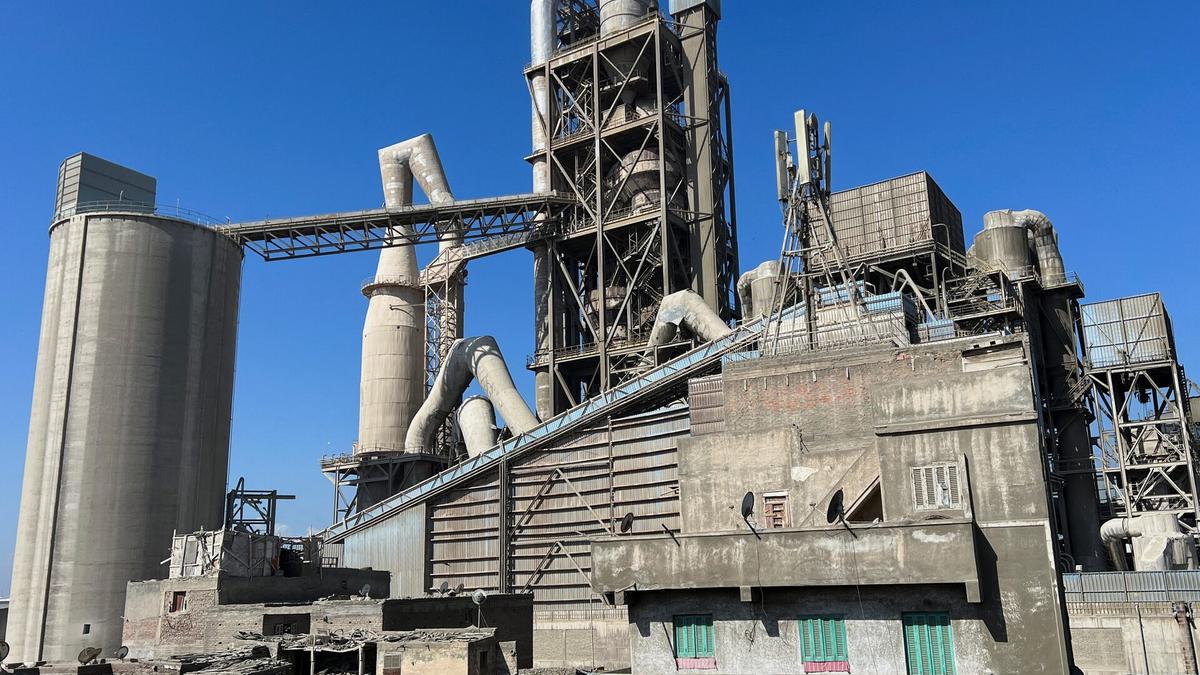
Black dust coats streets and collects on rooftops in the neighbourhood adjoining a sprawling cement factory in the Egyptian city of Alexandria. Activists and local residents accuse the plant operated by the Alexandria Portland Cement Company (APCC), a subsidiary of Greece’s Titan Cement, of fouling the air by burning coal. “Every night, we see particles falling from their chimneys.
Under street lights, you can clearly see the dust raining down,” said Mostafa Mahmoud, a grocery store owner in the Wadi al-Qamar neighbourhood. Reuters could not independently verify the assertion. Titan Cement says the plant’s emissions are within legal limits, and it plans to reduce its use of coal in coming years.
Like many cement manufacturers in Egypt and across North Africa, the factory uses imported coal to fire its kilns. Lately, more and more of the region’s coal is coming from the United States, according to U.S.
export data. Fossil fuel exports have been a hot topic at the United Nations climate conference in Baku this year, with activists and delegates from some climate-vulnerable countries arguing nations should be held accountable for the pollution they send overseas - often to poor developing nations - in the form of oil, gas and coal. Some are seeking to get the question of how to do this onto the agenda at future climate summits.
A landmark agreement reached in Paris in 2015 to fight climate change requires countries to set targets and report on progress reducing national levels of planet-warming greenhouse gas emissions. But it does not impose such requirements for emissions generated from fossil fuels they drill, mine and ship elsewhere. That has allowed countries like the United States, Norway, Australia and others to say they are making progress toward international climate goals while also producing and exporting fossil fuels at breakneck pace, said Bill Hare, co-founder of Climate Action Tracker, an independent scientific project that tracks government climate action.
“Most of these fossil-fuel-exporting countries can get to look good with their domestic climate action,” he said on the sidelines of the COP29 conference in Baku this week. “Their exported emissions are someone else’s problem.” U.
S. fossil fuel exports – including coal, oil, gas and refined fuels – led to over 2 billion tons of carbon dioxide equivalent emissions in other countries in 2022, according to a calculation carried out by Climate Action Tracker and verified by Reuters using data from the International Energy Agency. That is equivalent to about a third of U.
S. domestic emissions, the data showed. A years-long drilling boom has made the U.
S. the world’s top oil and gas producer, while robust demand has lifted its coal exports for four years running, according to data from the U.S.
Energy Information Administration (EIA). Asked how Washington squares its climate ambitions with its fossil fuel production and exports, President Joe Biden’s climate adviser, Ali Zaidi, said strong energy output was needed to keep consumer prices low during a transition to cleaner fuels. “I don’t think there is social license for a decarbonisation playbook that puts upward price pressure for retail consumers in the marketplace,” Zaidi told Reuters.
Incoming president Donald Trump, a climate change sceptic, has said he wants to further boost the nation’s fossil fuel production. For other producers, greenhouse gas emissions from fossil fuel exports sometimes outweigh domestic emissions, Climate Action Tracker said. That was true for Norway, Australia and Canada in 2022, the most recent year for which data is available for all countries analysed.
Reuters obtained exclusive access to the calculations. Norway’s Ministry of Climate and Environment said it is up to other nations to manage their own carbon footprints. “Each country is responsible for reducing its own emissions,” the ministry said in a statement to Reuters.
Officials at the environment and climate ministries of Canada and Australia did not comment. Addressing the summit in Azerbaijan, host President Ilham Aliyev accused some Western politicians of double standards for lecturing his government about its oil and gas use, saying, “They better look at themselves.” Cement and brickmakers Most U.
S. gas exports now go to European countries seeking to reduce dependence on Russia, while China has become one of the top buyers of U.S.
crude and coal, according to the EIA figures. America’s biggest growth market for coal, however, is North Africa. U.
S. coal mines exported around 52.5 million short tons globally in the first half of 2024, up nearly 7% from the same period a year ago, the data showed.
Much of the increase was driven by cement and brickmakers in Egypt and Morocco, which together took in more than 5 million short tons over the period, the EIA said in a recent report. “These customers value the high heat content of U.S.
thermal coal, which makes their manufacturing operations more efficient,” the report said. Meanwhile, U.S.
domestic coal use has been sliding as cheap natural gas and subsidies for renewables like solar and wind drive coal-fired power plant closures, extending a more than 15-year decline in greenhouse gas emissions. Egypt’s cement industry has relied on imported coal for nearly a decade, since persistent natural gas shortages forced many factories to look for alternatives, said Ahmed Shireen Korayem, vice chairman and board member at the Arab Union for Cement and Building Materials, a regional industry body. The U.
S. is Egypt’s largest supplier, accounting for 3.1 million of the 6.
6 million metric tons of coal imported this year, according to data from the London Stock Exchange Group. Russia supplied most of the rest, 2.1 million metric tons.
Its environment ministry referred questions to the foreign ministry, which did not immediately comment. Activists argue that the Egyptian government’s decision to lift a longstanding ban on coal imports in 2015 to support an industry central to its economic development plans is harmful to the environment and health of communities like Wadi al-Qamar. Using data from the Alexandria plant’s emissions-monitoring system, researchers from Egypt’s Al-Azhar University, Cairo University and environment ministry simulated the dispersion of polluting dust and toxic gases between 2014 and 2020.
The study, published in the Journal of Environmental Health Science and Engineering in 2022, concluded that the shift from using natural gas to coal as the dominant fuel lead to increased emissions and concentrations of total suspended particulates (TSP), nitrogen dioxide and sulfur dioxide. The concentrations were mostly within legal limits, however. Egypt’s greenhouse gas emissions from burning fossil fuels rose by more than a fifth in the decade ended in 2022, hitting 263 million metric tons of carbon dioxide, according to data from the Global Carbon Budget, a project led by Britain’s Exeter University.
Most of these emissions came from gas and oil, which remain Egypt’s main energy sources. Coal accounted for 3.4% of the 2022 total, 9 million metric tons.
The government committed in 2021 to phase out the use of coal and has asked companies that use it to introduce more renewable sources into their energy mix. But Heba Maatouk, a spokesperson for Egypt’s environment ministry, said there was insufficient supply of alternatives, such as refuse-derived fuel (RDF) made from combustible trash. “If companies cannot get the RDF, they won’t stop operating and will use coal to avoid losses,” Maatouk told Reuters.
Legal battles Decarbonising the cement industry is a challenge, particularly in poorer developing nations like Egypt, because it requires vast amounts of energy, and technologies to keep emissions from the atmosphere are expensive. In his COP29 address last week, Egyptian Prime Minister Mostafa Madbouly said his country’s plans to boost renewable energy to 42% of its power mix by 2030 depend on foreign support. Residents in the Wadi al-Qamar neighborhood have been engaged in a prolonged legal battle with the Alexandria cement factory, APCC, filing multiple lawsuits, said Hoda Nasrallah, a lawyer for the Egyptian Initiative for Personal Rights (EIPR).
In 2016, community members backed by EIPR asked an administrative court in Alexandria to overturn amendments to the country’s environmental regulations that allow heavy industries to use coal on health and environmental grounds, according to the rights group. APCC officials did not respond to a request for comment made through a legal representative. Titan Cement confirmed that the factory sources coal from the U.
S. but did not elaborate. In a statement issued by its group corporate communications director, Lydia Yannakopoulou, the company said the plant had not violated any laws, had made 40 million euros in investments in pollution controls since 2010, and planned to reduce its use of coal in coming years as it ramps up use of alternatives.
She said a court-appointed committee of experts from Alexandria University concluded there were no environmental violations resulting from the company’s emissions or operational processes, and the emissions were within legal limits. Nasrallah said lawyers representing the community believe the committee was headed by a company employee and have taken their case to Egypt’s highest administrative court in Cairo. Neither side provided a copy of the committee’s report, and Reuters could not independently verify their assertions.
A ruling in the case is expected in December. Meanwhile, frustration is building among nearby residents like Hisham al-Akary, who says his family has lived in Wadi al-Qamar for generations and cannot afford to move. “This factory shouldn’t be here,” he told Reuters.
“We should stay, and they should leave.” Published - November 23, 2024 02:07 pm IST Copy link Email Facebook Twitter Telegram LinkedIn WhatsApp Reddit carbon emissions / climate change (politics) / coal / oil and gas - upstream activities.













